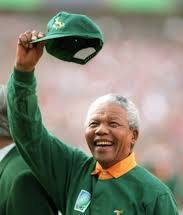
Leadership as tough choices – Mandela and the Springbok story
By Femi Olugbile
The springbok (Antidorcas marsupialis) is an antelope found mainly in southern Africa. It has a white face with a dark stripe running across it, and a light brown coat with a white rump flap.
Since 1906, it has been the symbol of the South African rugby team. By association, it became one of the most detested emblems of Apartheid, the system of racial discrimination and oppression that held the black majority of South Africa in bondage from the moment it was formalised as government policy in 1948.
The game of rugby itself was seen for a long time as almost exclusive to the white, mostly Afrikaner population.
By the time of the democratic elections, which ushered in President Nelson Mandela in 1994, black people had survived in the cauldron of Apartheid and were trying tentatively to adjust to the new reality. They still bore the scars of the oppression that was their recent lived experience.
The ‘white’ Springbok emblem, and even the ‘white’ game of rugby itself, were ogres from a past that they were trying to leave behind.
One day in the Eastern Cape province, the African National Congress was holding a political rally. Huge numbers of people had trooped in early, most of them eager to catch a glimpse of the main speaker – their new President Nelson Mandela. As usual at such rallies, there was a festive air, with music, dancing and great excitement.
As the President’s motorcade arrived, a great shout of welcome went out.
He was ushered to the podium.
A murmur slowly went up among the crowd as they got a closer look at the man they fondly referred to as ‘Madiba’. Over his usual colourful shirt, he was wearing a green cap with the yellow Springbok symbol. Many people stared in disbelief. This was the ultimate freedom fighter, wearing the symbol of the old oppressor.
Mandela went on to deliver a powerful speech, occasionally having to raise his voice over jeers and heckling from some sections of the audience.
As he went along, the crowd warmed to him.
By the end of the speech, the applause of his audience was deafening. He had won them over, at least for the day.
While in prison on Robben Island, Mandela had held long intimate discussions with some fellow anti-Apartheid prisoners. They had observed that he was a patient listener who would always hear the other person out. But he was adamant about his own point of view. He already had a sense of mission about his role in the history of South Africa, and a strong conviction that he needed to ‘understand’ his enemies and somehow win them over. This was at variance with the mood of most of the long-suffering black activists and the majority population, who wanted revenge and radical restitution.
His philosophy would be put to an early stress test over the issue of Chief Gashua Buthelezi and his Inkatha Freedom Party. Buthelezi, a Zulu prince, and his IFP were seen by many black people as traitors and collaborators with the Apartheid government. They had received favours from the white government and taken actions which undermined black solidarity and the liberation war. Many people assumed they would get their comeuppance and be viciously suppressed once a black government was in power. To their chagrin, Mandela not only cultivated Buthelezi after becoming President, he also gave him an important ministerial position in his government.
By this strategic move, he averted what would have been a vicious civil war between the Zulu and the rest of the nation. But many of his followers were angry with him.
And so back to rugby and June 1995, when several teams from around the world arrived in South Africa to play for the Rugby World Cup. The Afrikaner passion for the game of rugby was almost as intense as their commitment to their Dutch Reformed Church, which permitted Apartheid. Children learned the game virtually from the cradle.
That year, New Zealand’s team, the All Blacks, were the strongest team in the world, and considered the most likely to win the World Cup. But the Afrikaners were routing strongly for the Springboks, their home team, to do well.
In the end, the All Blacks and the Springboks qualified to face each other in the final match.
On the 24th of June, Ellis Park, Johannesburg hosted the final match of the tournament. The rugby-playing world was all agog, as were the 63,000 mostly white spectators at the stadium.
Suddenly a great roar went up in the stadium as President Mandela made his appearance. He was wearing the Springbok jersey and cap. On the back of his shirt was the number 6, the same number as the captain of the team, Francois Pinaar. Mandela lifted his cap and waved to the crowd. As one man, the crowd rose to their feet.
‘Nelson! Nelson! Nelson!’ they screamed.
The Springboks went on to survive a gruelling battle that lasted into extra time.
And they won.
When Mandela stepped proudly on the field to present the trophy to Pinaar, the cheering could be heard for miles around.
A journalist asked Pinaar later if his team won because they had 63,000 people in the stadium cheering for them. No, he replied. They won because they had 42 million South Africans cheering for them.
A nation had been born. What used to be an ‘enemy’ totem had been appropriated.
In 2018, Siya Kolisi would become the first black South African to captain the Springboks.
Today, the game of Rugby is making inroads in the townships, and several black players have worn the famous jersey of the Springboks.
The nation of South Africa itself is still work in progress, beset with developmental problems, advancing in spurts and starts. But Madiba’s tough leadership choice concerning the Springbok symbol has prevailed.
